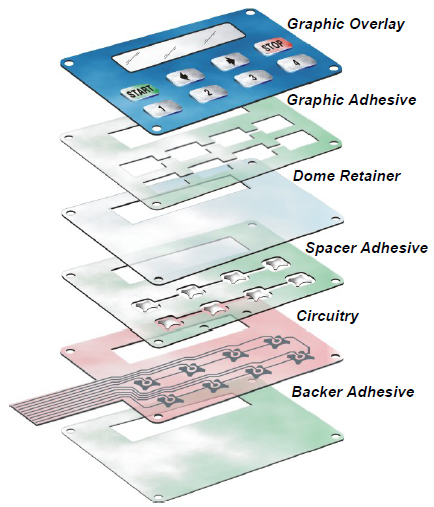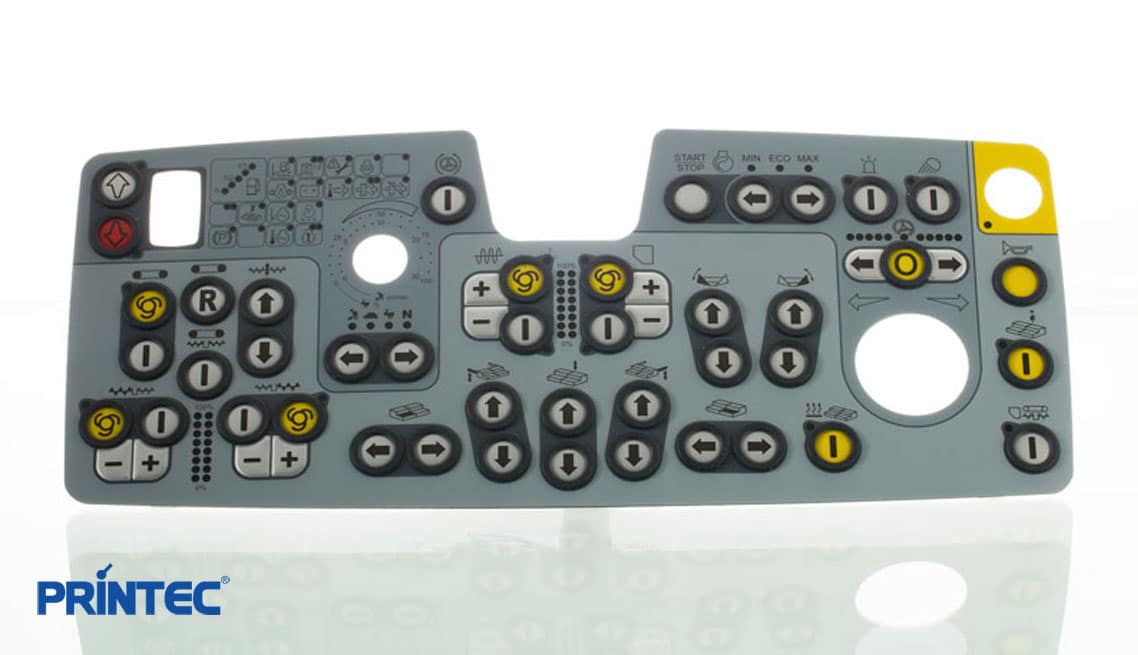Everything About Membrane Layer Switch Over: Understanding Its Design and Performance
When you believe concerning the control user interfaces in modern gadgets, membrane buttons often come to mind. Allow's discover what collections membrane layer switches over apart from various other control systems.
What Are Membrane Layer Switches?

Membrane layer switches can also be tailored concerning form, size, and graphics, permitting makers to create special interfaces customized to particular items. In general, membrane layer buttons play a significant duty in enhancing customer experience across a broad range of applications.
Just How Membrane Switches Over Work
When you push a key on a membrane layer button, it triggers an uncomplicated yet efficient device. The top layer, usually made from adaptable material, pushes down onto a conductive layer under it. This action bridges the space in between conductive traces, completing an electric circuit. As quickly as the circuit shuts, it sends a signal to the tool's controller, which analyzes your input.
You'll discover that the responsive responses varies based on the button style, supplying either a soft click or an extra obvious reaction. When you launch the trick, the membrane layer returns to its original setting, reopening the circuit and quiting the signal. This process happens practically instantly, making sure a receptive user experience.
Membrane switches are popular because of their durability and resistance to dirt and moisture, making them optimal for different applications, from family devices to clinical tools. Recognizing this procedure aids you value their prevalent usage.
Trick Elements of Membrane Layer Buttons
Understanding the key elements of membrane switches is essential for understanding their performance and style. At the core, you'll discover the graphic overlay, which offers the visual interface for customers. Under that, there's a spacer layer that divides the circuit layers, making certain that they do not make get in touch with up until pressed. The circuit layer is where the magic happens; it consists of conductive traces that complete the circuit when you push the switch. One more vital aspect is the adhesive backing, permitting the button to stick to surfaces securely. Ultimately, the safety layer shields against ecological variables and use, prolonging the switch's life-span. Each element plays a significant function in guaranteeing reputable efficiency and customer interaction. By comprehending these elements, you'll obtain insight into just how membrane layer changes run and their relevance in various applications.
Materials Utilized in Membrane Layer Change Layout
The performance and resilience of membrane layer switches greatly rely on the materials made use of in their design. You commonly experience polyester and polycarbonate as key substrates because of their superb strength and versatility. These products resist scrapes and chemicals, making them ideal for demanding settings.
The conductive layers frequently use silver or carbon, picked for their reliability and conductivity. membrane switch manufacturer. Silver supplies premium performance, while carbon is an economical option. For the overlay, you could consider a matte or glossy finish, depending upon your visual requirements and individual experience
Make particular to choose adhesives that stand up to environmental factors like temperature level and moisture. Selecting the right materials will guarantee your membrane layer button stands the test of time.
Layout Factors To Consider for Membrane Switches
While creating membrane buttons, it's vital to take into account numerous aspects that influence their capability and individual experience. Start by concentrating on the design and switch dimension; make certain they're instinctive and easy to navigate.
Confirm your design accommodates environmental elements, like wetness or temperature level variants, which can influence efficiency. By carefully considering these elements, you'll develop a membrane switch that enhances usability and satisfaction.
Applications of Membrane Switches
Membrane switches are flexible elements discovered in different applications, from industrial devices to consumer electronics. You'll see their impact in machines that need resilient interfaces and in devices that gain from sleek layouts. Comprehending these applications aids you value the performance and functionality of membrane switches in everyday modern technology.
Industrial Tools Use
When you're looking to enhance the capability of industrial tools, membrane buttons offer a trusted solution that incorporates durability with easy to use style. These buttons are ideal for extreme environments, supplying resistance to dirt, moisture, and chemicals. Accept membrane switches to enhance your procedures and improve overall performance.
Consumer Electronics Combination
In the domain of consumer electronics, membrane layer switches play a necessary duty in enhancing individual communication and device performance. You'll locate them in tools like microwaves, remote controls, and video gaming consoles, giving a seamless method to communicate with innovation. Their sleek design enables for simple assimilation into different products, making controls user-friendly and easy to use. With their capacity to include graphics and backlighting, you can enjoy a modern aesthetic that matches the gadget's general appearance. Membrane layer buttons additionally guarantee durability and resistance to dirt and wetness, expanding the life expectancy of your electronic devices. By picking membrane my latest blog post layer buttons, you boost not simply the capability but also the style of your devices, making everyday communications smooth and enjoyable.
Advantages and Disadvantages of Membrane Layer Buttons
While membrane layer switches offer a variety of benefits, they additionally come with some disadvantages that you need to think about. One significant benefit is their compact layout, making them optimal for space-constrained applications.

However, there are downsides. Membrane switches can have a much shorter life-span compared to mechanical switches, specifically under heavy usage. They can additionally be less tactile, which might impact customer feedback during procedure. In the original source addition, if damaged, repairing them can be difficult and often requires total substitute. Eventually, their level of sensitivity to severe temperature levels and environmental conditions may limit their performance in certain settings. Balancing these advantages and disadvantages will certainly aid you figure out if membrane layer buttons are the right fit for your job.
Regularly Asked Inquiries
For How Long Do Membrane Layer Switches Over Typically Last?
Membrane switches typically last in between 5 to one decade, relying on use and ecological conditions. You'll want to review elements like wear, exposure to dampness, and temperature level changes to evaluate their longevity effectively.
Can Membrane Switches Over Be Custom-made for Certain Styles?
Yes, you can customize membrane buttons to fit certain styles (membrane switch manufacturer). You'll have the freedom to choose shades, forms, and designs that match your job's requirements, guaranteeing they blend effortlessly with your general visual
What Is the Price Variety for Membrane Switch Over Manufacturing?
The cost range for membrane layer switch production commonly drops between $1 and $10 each, relying on elements like design intricacy, quantity, and products. You can obtain quotes from producers to locate the very best option.

Are Membrane Switches Water-proof or Resistant?
Membrane switches can be created to be waterproof or immune, depending upon materials made use of and building and construction techniques. If you need them for damp atmospheres, guarantee you define those needs during the layout process.
Just How Do Membrane Layer Switches Contrast to Typical Switches?
Membrane layer buttons are typically thinner and a lot more flexible than typical buttons, using a sleek layout. They're commonly much easier to clean up and incorporate, but could not offer the responsive comments you're used to with mechanical choices.
Conclusion
